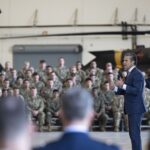As a geopolitical analyst, I’ve spent my career studying the leveraging of military might and economic sanctions. So it surprised me when Pope Francis’s death on April 21 left me with a sense of genuine loss, not for religious reasons (I am not religious), but because of the vacuum left in the world. Francis represented something increasingly rare in international affairs: a global figure who wielded significant influence without controlling a single weapon or economic sanction.
Over 12 years, Francis transformed Vatican diplomacy into a modern soft-power institution. He didn’t ask nations to obey but to believe — to see the moral stakes in migration, poverty, and climate not as Catholic issues but human ones. His diplomatic toolkit offers valuable lessons about influence beyond military and economic might.
Francis’s most powerful diplomatic tool was his ability to reframe technical policy debates as moral imperatives. His 2015 encyclical Laudato Si’ redefined climate change from an environmental policy issue to a spiritual crisis. Released months before the Paris Climate Agreement negotiations, the document condemned how unbridled capitalism destroys the planet and hurts the already impoverished. According to former United Nations Secretary-General Ban Ki-moon, Francis’s moral exhortation helped overcome diplomatic inertia at the climate talks.
Similarly, Francis elevated migration from a security concern to a moral test of humanity. His first official trip outside Rome in 2013 was to Lampedusa, Italy — a primary entry point for refugees and migrants crossing the Mediterranean. There, he mourned thousands who had drowned and lamented what he called the “globalization of indifference” toward migrants’ suffering. This framing challenged wealthy nations to see migration through a human lens rather than purely as a border control issue.
*
Francis deployed dramatic personal gestures that resonated beyond formal declarations. In April 2019, at a Vatican retreat for South Sudan’s warring leaders, the 82-year-old pope, despite chronic leg pain, knelt and kissed the feet of President Salva Kiir and opposition leader Riek Machar, imploring them to maintain peace. The startling act of humility reportedly moved the leaders to tears and reinforced ongoing peace efforts.
These gestures made Francis’s diplomacy visually compelling in ways traditional statecraft rarely achieves.
Other powerful symbolic acts included bringing Syrian refugee families to Rome from Greece in 2016, and creating the first-ever joint declaration between a pope and Sunni Islam’s Grand Imam of al-Azhar in Abu Dhabi in 2019. Later, in 2021, he became the first pontiff to visit Iraq, meeting with Grand Ayatollah Ali al-Sistani to demonstrate how different faiths “can and should coexist in harmony.” These gestures made Francis’s diplomacy visually compelling in ways traditional statecraft rarely achieves.
The Vatican under Francis excelled at quiet facilitation between adversaries. The clearest example came in 2014, when Francis played a pivotal role in restoring diplomatic relations between the United States and Cuba after five decades of Cold War hostility. Francis wrote personal letters to Presidents Obama and Raúl Castro, while Vatican diplomats hosted secret delegations from both countries that set the groundwork for the breakthrough.
*
Francis pioneered diplomatic coalitions across religious lines, particularly with Islamic leaders. In 2019, he signed the Document on Human Fraternity with Sheikh Ahmed el-Tayeb, the Grand Imam of al-Azhar, condemning religious extremism and affirming shared human dignity. This declaration later inspired a UN resolution and the creation of the International Day of Human Fraternity.
His 2016 meeting with Russian Orthodox Patriarch Kirill in Cuba — the first between a Roman pontiff and Russian patriarch since the 1054 schism — demonstrated his commitment to bridging ancient divides. Though some Ukrainian Catholics who felt it favored Moscow amid Russia’s actions in Ukraine criticized the move, Francis judged that extending a hand to Kirill was worth the risk if it could inch Christianity toward greater solidarity.
At the same time, Francis maintained traditional Vatican neutrality in conflicts, not to avoid engagement but to preserve humanitarian channels. The Holy See has remained neutral in wars since the 1929 Lateran Treaty, which also stipulates it cannot mediate unless invited by all parties. This approach enabled Vatican diplomats to facilitate prisoner exchanges between Russia and Ukraine and assist in the return of Ukrainian children deported to Russia.
While neutrality preserved humanitarian access, it sometimes generated controversy. Francis’s reluctance to directly condemn Russia’s invasion of Ukraine and his suggestion that Ukrainians “have the courage of the white flag” frustrated many Ukrainians, who saw his approach as downplaying their existential struggle. Vatican officials, however, maintained that this neutral posture enabled critical humanitarian work that more partisan actors couldn’t accomplish.
*
Francis recognized that internal Vatican reform strengthened its external moral authority. He addressed clergy sexual abuse through institutional changes like Pascite gregem Dei, which updated Church law to strengthen penalties for sexual abuse and financial crimes. While many survivors’ advocates argued these reforms fell short, they marked a notable pivot after years of denial and protectionism.
He also reformed the Vatican’s diplomatic corps by elevating experts with regional knowledge — particularly from the Global South — to key positions. Cardinal Pietro Parolin, his secretary of state, led a revitalized diplomatic team with greater expertise in regions previously underrepresented in Vatican diplomacy.
*
Francis’s diplomatic approach, of course, was not without serious criticisms. His 2018 agreement with China on bishop appointments faced condemnation from figures like Cardinal Joseph Zen of Hong Kong as “an incredible betrayal” that sent underground Catholics “into the mouths of wolves.” Critics argued the secretive deal gained minimal religious freedom while lending legitimacy to an authoritarian regime.
His response to the Rohingya crisis in Myanmar illustrated another limitation. During his 2017 visit, Francis avoided using the term “Rohingya” while in Myanmar, following advice from local Church officials who feared backlash against the Catholic minority. Human rights groups criticized this omission, with a Human Rights Watch director noting the Rohingya had been stripped of everything “but their name should never be one of them.”
These controversies highlighted the core tension of moral diplomacy: balancing principled advocacy with pragmatic engagement in a complex world.
*
In an era where transactional statecraft and nationalist realpolitik have dominated — from Erdoğan’s neo-Ottoman posturing to Xi’s coercive regional diplomacy — Francis’s approach modeled an alternative. He didn’t command armies or economies, but through credibility and moral framing, he often gained influence beyond his material power. His influence was relational, not transactional.
Francis’s death leaves a vacuum not just ecclesiastical but geopolitical. As multilateral institutions erode and ethical leadership recedes, his absence leaves a gap in values-driven diplomacy precisely when the world needs it most. No current world leader approximates his unique combination of moral clarity and diplomatic pragmatism. As Francis himself wrote in Fratelli Tutti: “Politics too must make room for a tender love of others.”
In a world defined by force, perhaps this tenderness was his most revolutionary diplomatic innovation. At a time when many world leaders wield influence through force or finance, Francis led with something rarer: moral clarity fused with institutional humility. In the coming years, the question isn’t whether another pope will replicate his strategy — but whether any world leader, religious or secular, will.




















